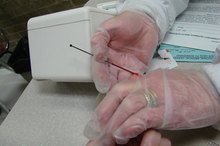Does Losing Weight Help Lower Elevated Liver Enzymes?
Elevated liver enzymes in the blood are often the first, and sometimes only, sign of liver problems. Liver enzymes increase when damage to the liver causes the liver cells to release enzymes into the bloodstream. Nonalcoholic fatty liver disease, often called NAFLD, is liver damage not caused by excessive alcohol intake. The most common type of NAFLD is accumulation of fat in the liver, called fatty liver disease. The most common cause of NAFLD is overweight or obesity, but other types of liver disease also can elevate liver enzymes.
If you are experiencing serious medical symptoms, seek emergency treatment immediately.
Effects of Being Overweight
Up to 20 percent of adults and 5 percent of children have NAFLD. Among obese adults, the percentage rises to 66 percent, with 50 percent of obese children having a fatty liver, according to the American College of Gastroenterology website 2. Mild liver enzyme elevations are the typical sign of fatty liver disease, but it can occur in obese people even without liver damage. Liver enzymes are normally elevated between 40 percent and 50 percent in people with a higher than normal body mass index, according to Michael Kreier, M.D. of the University of Pennsylvania. Fatty liver disease caused by obesity is reversible with weight loss 1.
Risks
The Signs & Symptoms of Mild Diffuse Fatty Infiltration in the Liver
Learn More
Fatty liver by itself is not harmful; however, in 2 percent to 5 percent of cases, fatty liver progresses to a more serious type of liver damage called nonalcoholic steatohepatitis, or NASH, the National Institute of Diabetes and Digestive and Kidney Disorders reports. NASH generally has no symptoms until the disease becomes more advanced and cirrhosis develops. Cirrhosis is characterized by replacement of normal tissue with fibrotic or scarred areas that can no longer perform the normal liver functions. At this point, liver damage is generally irreversible. NASH is one of the main causes of cirrhosis, behind hepatitis and alcoholism. It can result in complete liver failure and the need for a liver transplant.
- Fatty liver by itself is not harmful; however, in 2 percent to 5 percent of cases, fatty liver progresses to a more serious type of liver damage called nonalcoholic steatohepatitis, or NASH, the National Institute of Diabetes and Digestive and Kidney Disorders reports.
- Cirrhosis is characterized by replacement of normal tissue with fibrotic or scarred areas that can no longer perform the normal liver functions.
Reversal
Losing weight can reverse fatty liver and decrease the risk of liver failure in people with NASH. A study in the January 2009 issue of “Hepatology” found that overweight people who lost 5 percent of their body weight reduced fat in their liver over a nine-month period, and those who lost 9 percent of their body weight reversed liver damage from NASH. Reversing liver damage lowers liver enzymes.
Considerations
What Does High Enzymes Mean?
Learn More
Losing weight will not lower liver enzymes unless the cause of the elevation is because of the weight. A number of other diseases, including hepatitis C, can raise liver enzymes. In these cases, losing weight will not benefit the person unless they’re also overweight. The ratio of two liver enzymes, AST and ALT, is usually less than 1.0 in NAFLD, according to Dr. Krier. An elevated AST:ALT ratio of 2.0 or greater is more commonly seen in alcoholic liver damage, and an elevated AST:ALT ratio greater than 1.0 may indicate cirrhosis in people with hepatitis.
- Losing weight will not lower liver enzymes unless the cause of the elevation is because of the weight.
- The ratio of two liver enzymes, AST and ALT, is usually less than 1.0 in NAFLD, according to Dr. Krier.
Related Articles
References
- Science Daily: Weight Loss Improves Fatty Liver Disease, Researchers Find
- American College of Gastroenterology: Fatty Liver Disease
- Penn Medicine:The Asymptomatic Outpatient with Abnormal Liver FunctionTests
- National Institute of Diabetes and Digestive and Kidney Disease. What Is NAFLD and NASH?
- National Institute of Diabetes and Digestive and Kidney Disease. What Is NAFLD and NASH?
- National Institute of Diabetes and Digestive and Kidney Disease. How Can My Diet Help Prevent or Treat NAFLD or NASH?
- US National Library of Medicine. Medline Plus. Fatty Liver Disease.
Writer Bio
A registered nurse with more than 25 years of experience in oncology, labor/delivery, neonatal intensive care, infertility and ophthalmology, Sharon Perkins has also coauthored and edited numerous health books for the Wiley "Dummies" series. Perkins also has extensive experience working in home health with medically fragile pediatric patients.









